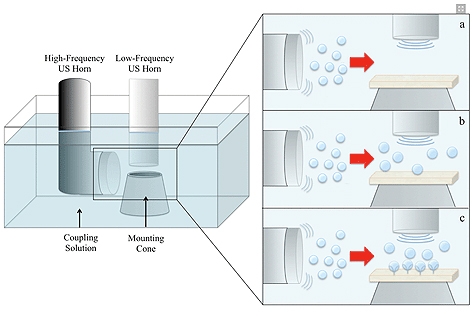The technique, which uses two ultrasound beams of different frequencies, could aid the development of needle-free vaccinations and drug-delivery systems, the researchers claim.
In a paper in the Journal of Controlled Release, MIT chemical engineers Prof Daniel Blankschtein and Prof Robert Langer and colleagues describe how two ultrasound beams, one of low frequency and the other of high frequency, effectively ‘wear away’ the top layer of the skin they are applied to, allowing drugs to make their way through the skin and into the bloodstream. The skin damage is temporary, they claim, and doesn’t cause any pain.
The technique works because of the behaviour of bubbles, according to the team. It involves pushing ultrasound energy into a layer of liquid on the skin. The sound waves generate bubbles in the liquid, which grow until they become unstable, then implode. This sends liquid rushing into the space left by the bubble, which generates a high-speed liquid microjet with enough energy to scratch the surface of the skin.
This effect has been known for some time, but only low-frequency waves have been used because these have more energy; high-frequency waves were thought to have insufficient energy to make unstable bubbles that pop. However, the low-frequency waves tend to create a rather scattered pattern of skin abrasion that doesn’t allow a high enough dose of drug molecules present in the liquid film to penetrate the skin.
Adding high-frequency waves to the low-frequency ones has two effects, the team said in a statement. First, they generate more bubbles, which the low-frequency waves then pop. Second, they stop the bubbles moving sideways along the liquid film, creating a more uniform abrasion area and allowing more drug molecules through the skin.
In experiments on pig skin, the team found that the two-frequency approach allowed glucose to be absorbed 10 times better than a single-frequency treatment, while the protein inulin was absorbed four times better.
The researchers are now working on using the technique for vaccines, which would be easier to administer transdermally than via injection — a major advantage for the developing world, where there is a shortage of people trained to give injections. They are also working on a prototype handheld ultrasound device and on ways to improve skin permeability even more.






Red Bull makes hydrogen fuel cell play with AVL
Formula 1 is an anachronistic anomaly where its only cutting edge is in engine development. The rules prohibit any real innovation and there would be...